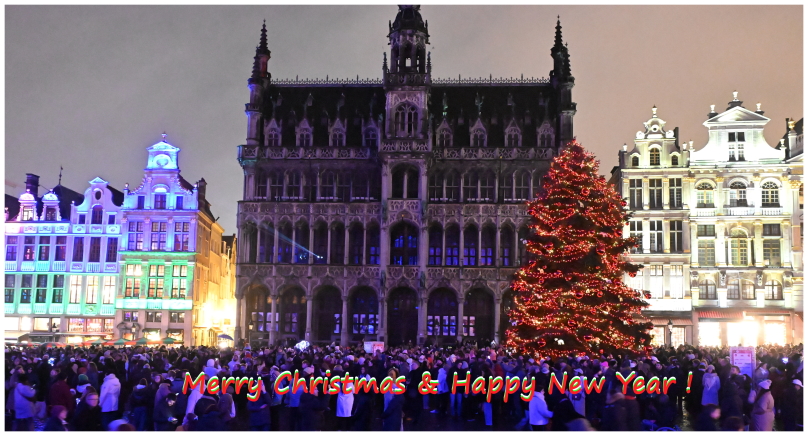The Meetjesland in the north of East-Flanders, Belgium

Oostwinkel, a Meetjesland town
Excavations near the Mostmolen (molen = mill) in 1991-92 proved occupation in prehistoric times. The name is first mentioned as Wostwinle in 1216 and Wostwinkala in 1220. It is composed of two Germanic words, wostu meaning desert, wasteland and winkala meaning the back of beyond, an out of the way place. It bordered on the Zomergem and Maldegem Corporations. It belonged to the Chancellery of the "Oudburg" (Old Fortress) of Ghent and to the Freedom of Bruges.
 Of old the Seigneury of Oostwinkel together with Zomergem,
Ronsele and part of
Waarschoot was part of the Zomergem
Corporation. But then this wild outpost attracted so many new
"settlers" that during his historic grand tour of 1244 the bishop of
Doornik (Tournai) Walter van Marvis decided to separate Oostwinkel from
Zomergem and to turn it into an independent
parish. This he did at the request of Willem van Westwinkel, who at the time
was in charge of the chapel that was there already and this to the great displeasure
of the parish priest of Zomergem whose income was of course reduced.
Of old the Seigneury of Oostwinkel together with Zomergem,
Ronsele and part of
Waarschoot was part of the Zomergem
Corporation. But then this wild outpost attracted so many new
"settlers" that during his historic grand tour of 1244 the bishop of
Doornik (Tournai) Walter van Marvis decided to separate Oostwinkel from
Zomergem and to turn it into an independent
parish. This he did at the request of Willem van Westwinkel, who at the time
was in charge of the chapel that was there already and this to the great displeasure
of the parish priest of Zomergem whose income was of course reduced.
The Oostwinkel Seigneury had a very complicated feudal structure. Besides the senior Seigneury there were 10 other Seigneuries in Oostwinkel, of which the Baronetcy of Leischoot was the most important. The heart of the Seigneury was Castle domain which you reached from the village by way of the Loan Drive or Castle Drive. In 1782 the domain consisted of a castle, a house for the farmer, two coach-house, a lease-hold property, orchards, drives, land and vast ponds. At the beginning of the 19th Century the whole complex was extensively rebuilt in accordance with plans drawn up by Minard, a famous architect. Yet now hardly anything is left of all that.
 The first well known Lord of the Seigneury was "Walteri
de Wostwincle" (1216). After him Oostwinkel came successively in the
hands of the Cleyte, van Halewyn, Beaufort, Casembroot, van Maldeghem and
finally the very well known Walckiers family.
The first well known Lord of the Seigneury was "Walteri
de Wostwincle" (1216). After him Oostwinkel came successively in the
hands of the Cleyte, van Halewyn, Beaufort, Casembroot, van Maldeghem and
finally the very well known Walckiers family.
When the Ancien Regime fell the seigneury had just been acquired by Papeleu, a patrician family from Ghent.
During the era of French rule Oostwinkel became an independent town with its own town counsel. It remained an isolated place for most of the 19th Century, because the links with the surrounding towns were bad or, most of the time, useless. And this situation remained almost unchanged until the fifties. Thanks to a dynamic burgomaster (Van Haele) it was hauled out of its isolation and then followed a spectacular boom with plenty of new homes being added in the town center, in the Langestraat (Long Street) and Veldstraat (Field Street). Nevertheless Oostwinkel remains a quiet rural town.
Oostwinkel was in the firing line during both World Wars. In October 1918 it was thoroughly sacked by retreating German troops and the church and several houses were very badly damaged.
 On 29 June 1936 the town was
hit by a very bad hurricane which uprooted many trees and destroyed quite a few
barns and homes. It also did terrible damage to the church. And for
a few days Oostwinkel was the center of our
Meetjesland while so many
tourists came to gape at the sights.
On 29 June 1936 the town was
hit by a very bad hurricane which uprooted many trees and destroyed quite a few
barns and homes. It also did terrible damage to the church. And for
a few days Oostwinkel was the center of our
Meetjesland while so many
tourists came to gape at the sights.
The WW II military operations meant the death of several dozen Belgian soldiers but after the war there was also the repression which left deep scars of a different kind in this small community.
Oostwinkel had a couple of famous parish priests. There was for instance the poet-priest Martijn De Smet (1550-1560). A few of his sonnets have been preserved. But he converted to Protestantism and for that reason he was hanged in Mechelen (Malines) in 1567. His successor Jan Teerlynck (1560-1566) personally led the iconoclasts on 23 August 1566 which meant the destruction of practically the whole interior of his church.
Oostwinkel now has about 725 inhabitants. It is now administratively part of Zomergem.
Pictures of Oostwinkel's church
More pictures from Oostwinkel
 |
Here
you may find a few pictures of Oostwinkel made by Mr. Romano Tondat between 1962 and 1975: the great Romano Tondat Meetjesland Picture Collection |
Source: "Streekgids Meetjesland" (Meetjesland Regional Guide), pp. 94-95 by Hugo Notteboom.

More pictures
Our Meetjesland
— Table of Contents
— Find something in this Meetjesland website

MijnPlatteLand.com
Most recent update : 22-04-2021
Copyright Notice (c) 2025
